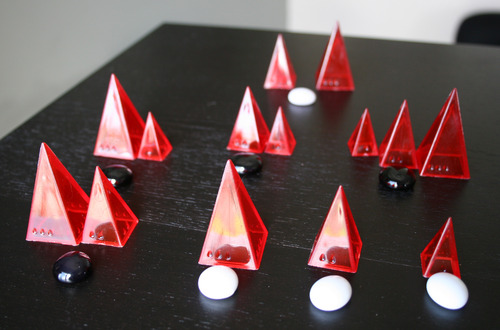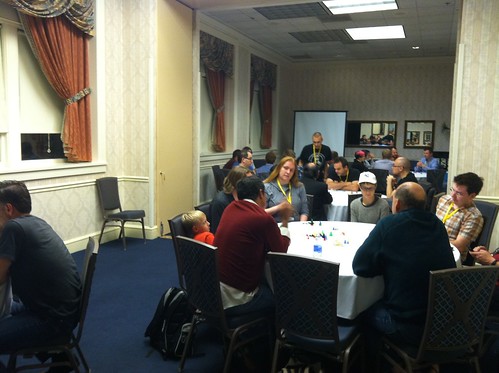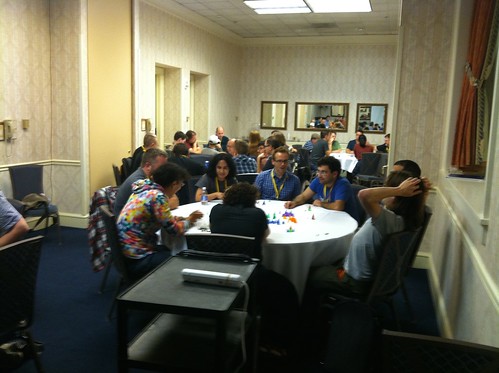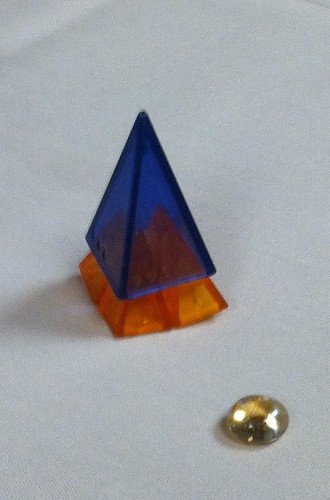Games of interest: Zendo
I recently held a Zendo unsession at the 2014 Strange Loop conference in St. Louis and described the game as the scientific method in a box. While perhaps too general, I believed that the tech, mathematical, and scientific-minded crowd at Strange Loop would appreciate the game very much. However, before I talk about the unsession, allow me to take a few moments to talk about the game itself.
Introduction to Zendo
Zendo is a game of inductive logic. One person plays the Master and creates a rule that dictates the layout of tiny installments of crystalline pyramids or other such trinkets. The other players then construct their own arrangements (called koans) in hopes of learning which follow the rule (marked in white) and which do not (marked in black). Gradually the secret rule is uncovered by the players in a cooperative1 realization of truth.
For example, the rule that dictates the following arrangements is No two pieces can touch.

Preparation
40-50+ building pieces. I prefer Looney Pyramids, but something like Legos would suffice too. I’ll assume pyramids for the purposes of this post.
A bunch of stones or other small bits; preferably of three different colors. Stones of two colors will be used as “marking stones” for the master and “answer stones” for the players, and the third colored stones used as “guessing stones.”
The pyramids are placed within reach of all of the players and the game is ready to start.
Gameplay
The game starts with the Master devising a secret rule such as “a koan must contain an orange piece” or “the number of pyramids must be an even number.” Devising rules that will not frustrate the players takes some practice, so it’s best to start simple2, especially if the other players are new to the game. That said, the Master then builds two structures: one that follows the secret rule and one that does not. Once done, the game can begin.
Player turns
On each turn a player arranges their pyramids into a structure (called a “koan”) and says either “master” or “mondo.” By calling “master” the player is simply asking the Master to mark if their structure follows the secret rule or not. When they call “mondo” they are effectively asking for a peer review of their structure. What this means is that each player hides either a black or white stone in their hand corresponding to whether or not they think the new structure follows the rule as they understand it.3 The Master also hides a stone and once ready all of the players simultaneously reveal their stones. Whomever matches the color of the Master’s stone gets a new guessing stone. Before moving to the next player’s turn, the current player may choose to spend a guessing stone to make a verbal guess at the secret rule.
Ending the game
If a player guesses the rule correctly on their turn the game is over and that player gets a point. However, if the player incorrectly guesses then the master must build a contradicting structure. That is, the Master must build a structure that simultaneously follows the secret rule while also contradicting the player’s guess. If at any time the Master is unable to build a contradictory structure then the guessing player wins the game and gets a point. For the purposes of Zendo, guessing a rule that cannot be disproven is as good as guessing the original secret rule.4
Until a player guesses the secret rule the previously built structures should remain on the play area so that players can look them over in hopes of discovering the patterns. Zendo is great fun and I’ve found it to be a hit amongst scientifically-minded people.5 The rules above can’t express the joy of this game, but Alex Payne once wrote about Zendo in such a way that more appropriately gives the sense of what it’s like to play Zendo.
A Zendo session at Strange Loop 2014
Prior to attending Strange Loop 2014 I decided to try running a Zendo unsession one of the nights of the conference. I had ~10 people sign up on the conference site and brought enough pyramids sufficient for ~4-5 groups. My session was due to start at 9pm and due to very slow service at a restaurant I arrived about 5 minutes late. The room was filled, but I suspected that the previous session had run over. I immediately spoke up and asked “how many people are here to discover Zendo?” Every single hand went up…
…
That is, ~30-35 hands went up.
…
I was in trouble.
Thankfully, with an emphasis on “thank”, a couple (Danielle and David) immediately stood up and pulled out a huge stash of pyramids! They also knew and loved the game and offered to help. Once we ran through the rules, we split up the pyramids, split up the Masters and started. Both Danielle and David ran a table each and managed to teach their players the traditional Zendo rules as outlined above. However, as I was Mastering 3 tables to start6, I went with a simplified version of the rules and jumped from table to table.

Zendo was a immediate hit. The players, though most were new to Zendo, instantly “got it.” There were constant congratulations on finding the rules and echoes of “let’s play another.” I mastered about 9 games between 3 tables, but soon was able to relax, vet some rules, and just sit and play once the other players felt confident to be Master. I still jumped from table to table to play a rule or two (and got in ~20 games by night’s end) but after a while the tables were off and running without intervention. It was a thing of beauty.

I stayed until the end of the last game … which ended at about 1am. That’s 4 hours of Zendo played and enjoyed by 40-50 people (all told), many whom were new to the game.

Thanks to everyone who attended, and especially to David and Danielle for bailing me out of a potentially embarrassing lack of pyramids. The Zendo session was a smashing success.
I hope you’ll give it a try.
:F
-
Zendo can be as adversarial or as cooperative as you like. I prefer to play in such a way that the players feel like they’re all working towards discovery. Whenever I play master I like to encourage the players openly discuss their ideas with the other players. YMMV ↩
-
Looney Labs has a set of Zendo rule cards that you can add to any order from their website for free. These cards have a nice set of beginner rules. ↩
-
Or as they think that they understand it. ↩
-
I always prefer playing Master because I find building the contradicting koans to be an interesting challenge. Likewise, in the rare occasion where I’m unable to disprove a guess, it’s always fun to discuss with the players afterwards to see if anyone has any ideas how it could have been done. ↩
-
Looney Labs has a different ruleset for Zendo called “Xendo” (PDF) that’s scientifically themed rather than of a spiritual nature. ↩
-
I was quickly relieved of one table by Howard Lewis Ship, which was a huge help. ↩


No Comments, Comment or Ping
Reply to “Games of interest: Zendo”